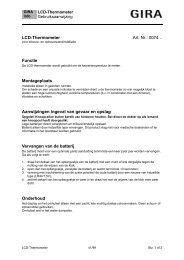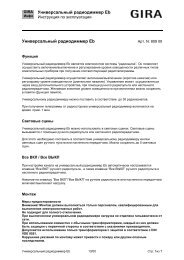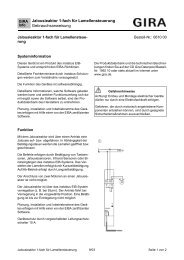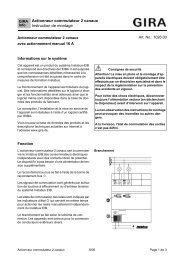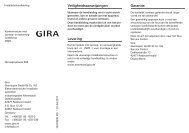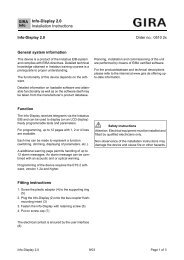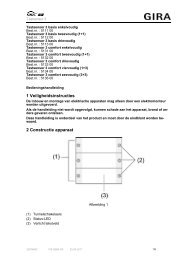Blind actuator 1-gang flush-mounted Order-No. 2165 00 - Gira
Blind actuator 1-gang flush-mounted Order-No. 2165 00 - Gira
Blind actuator 1-gang flush-mounted Order-No. 2165 00 - Gira
You also want an ePaper? Increase the reach of your titles
YUMPU automatically turns print PDFs into web optimized ePapers that Google loves.
Software "Venetian blind, input 20BD11"<br />
Functional description<br />
4.2.4.4.3 Positioning and feedback settings<br />
Computing the blind height or the louver position<br />
The device has a easy-to-use and accurate positioning function. The device calculates the<br />
current position of the connected Venetian blind, roller shutter, awning or louver whenever these<br />
elements are adjusted either by manual or bus control. The calculated position value is a<br />
measure of the height of the blind or of the opening width of the venting louver (Figure 14).<br />
Figure 14: Positions defined as a function of the type of movement<br />
The device derives the positions from the configured travelling time since conventional drives do<br />
not provide feedback about their positions. Thus, the travelling time configured in the ETS is the<br />
reference for all position approaches and of basic importance for the accuracy of the position<br />
calculations. For this reason, the travelling time should be determined with great accuracy in<br />
order to achieve the best possible positioning results.<br />
For positioning purposes, the device calculates the movement time required as a function of the<br />
current position.<br />
Example 1...<br />
The roller shutter connected to the certain output has an overall travelling time of 20 s. The<br />
roller shutter is in its upper end position (0 %). It is to be positioned at 25 %. The device<br />
calculates the movement time required for approaching the desired position:<br />
20 s × 0.25 (25 %) = 5 s. The output will then lower the roller shutter for 5 s and thus position the<br />
blind at height of 25 %.<br />
Example 2...<br />
The shutter connected to the certain output has an overall travelling time of 20 s. The shutter is<br />
in the 75 % position. I It is to be positioned at 75 %. The difference between the positions is<br />
50 %. The device calculates the movement time required for bridging the difference between<br />
the positions: 20 s × 0.5 (50 %) = 10 s. The output will then lower the roller shutter for 10 s and<br />
thus position the blind at height of 75 %.<br />
With all the upward movements, the configured movement time extension is automatically<br />
added to the calculated movement time.<br />
Example 3...<br />
The roller shutter connected to the certain output has an overall movement time of 20 s. The<br />
roller shutter is in the 75 % position. It is to be positioned at 25 %. The difference between the<br />
positions is 50 %. The device calculates the unextended movement time required for bridging<br />
the difference between the positions:<br />
<strong>Order</strong>-<strong>No</strong>. <strong>2165</strong> <strong>00</strong><br />
Page 44 of 149



